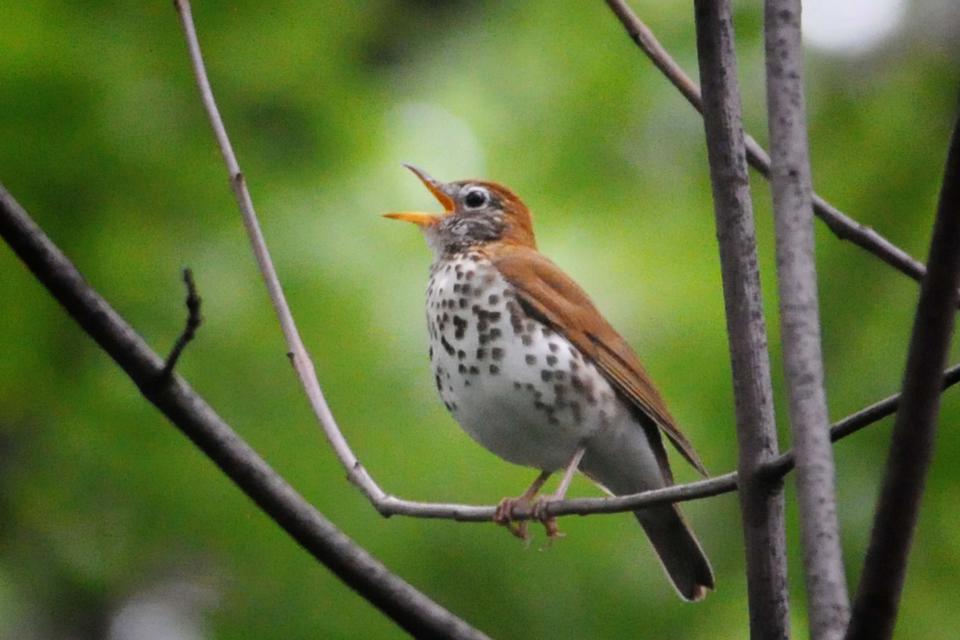That wonderful sound you hear in the trees is from the wood thrush. Here's its story.
Surely the most beautiful sound in the forest is that of the wood thrush song.
Likened to the ethereal notes of a flute duet, the song's three varying parts always include one signature constant: the haunting "ee-oh-lay."
Males apparently produce this so-called duet with themselves by forcing air simultaneously through the two bronchial parts of the syrinx, or voice box. What a trick! Since bird song is always about love and war, the wood thrush's double song must certainly put him among the best of the Romeos and tops in the army.
After a 1,700-mile migration from Central America to their spring breeding range, male wood thrushes typically arrive here mid- to late April and immediately begin robust singing from mid-canopy trees, usually amid a leafless opening, vocalizing especially at dawn and dusk as well as intermittently all day long.
The singer performs to attract a mate (love) and defend his territory (war). Competing males will answer one another's songs with a different − and, he surely hopes, better − variation. Flute duets abound.
Marital arrangements and home sites finally established, the birds settle in and song grows more and more sporadic. Then, once the pair's three or four nestlings hatch, daddy duties silence his arias altogether.

So if the love-war scenario is over, why, then, have the local wood thrushes returned to their morning, evening, and sporadic all-day dueting, now, in July? Quite simply, the scenario is actually far from over.
Wood thrushes typically fledge two broods annually. While that sounds simple enough, they sometimes need three or four full-fledged efforts to do so. Indeed, every attempted new brood mandates the same love-and-war efforts as did the first. There are new nests to build, sometimes in new territories. And there may be a new love to charm.
For instance, if one or more nearby pairs has lost a mate, the widow is on the search. Sing! May the best man win.
Every male must ramp up his attractiveness, either to keep his mate or, widowed, attract a new one. War could be eminent. Repeated nest failures may also translate into an alternate love affair. Maybe a new love will have better nesting success. In the bird world, there are only two goals: to eat so they can breed. No matter how simple and unadorned that seems, birds' lives are never easy.
And thus he sings in July. Morning, evening, and off-and-on during the day, the clear flute songs once again spill from the forest. The last babies often fledge from the nest in late August. At that late date, the youngsters must learn to fly well, avoid predators, find food, gain strength, and, within weeks of leaving the nest, depart for a 1,700-mile migration. Alone. No road map.
Local news: 'No closure ever:' Mother seeks justice 8 years after Evansville DJ's shooting death
In spite of their annual two broods, wood thrushes face serious decline. Forest fragmentation is the primary cause. That's because fragmentation creates perfect cowbird habitat, and cowbirds habitually parasitize wood thrush nests − meaning cowbirds lay eggs in wood thrush nests, crowding out the hosts' own babies.
The impact of predation precipitated by forest fragmentation is further heightened by shrinking forests in their winter range. Facing the double whammy, wood thrush populations have shrunk to less than half of that 40 years ago.
How soon before we no longer hear the flute duets?
For more information about birds and bird habitat, see Sharon Sorenson's books How Birds Behave, Birds in the Yard Month by Month, and Planting Native to Attract Birds to Your Yard. Follow daily bird activity on Facebook at SharonSorensonBirdLady, or email her at chshsoren@gmail.com.
This article originally appeared on Evansville Courier & Press: The wood thrush sings twice year to attract partners

